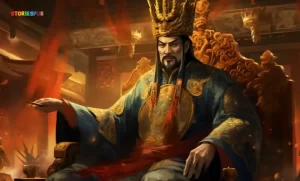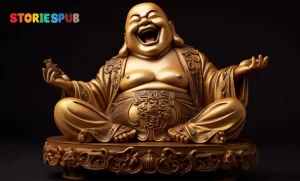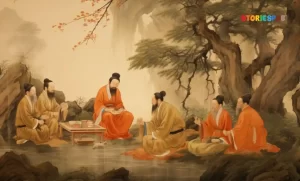The Story of the Five Elements in Chinese Mythology

In the beginning, there was chaos, and from this chaos emerged the universe. In this universe, there were five elements – Wood, Fire, Earth, Metal, and Water. These elements were not just physical substances but were also thought of as spiritual energies that governed the workings of the universe.
According to Chinese mythology, the concept of the Five Elements can be traced back to the ancient times when the universe was created. It is believed that the universe was initially in a state of chaos, and from this chaos emerged the Five Elements, which were the fundamental building blocks of all matter in the universe.
The Chinese believed that everything in nature was made up of these Five Elements, and they interacted with each other in specific ways. This interaction between the elements was believed to be responsible for the creation, growth, and transformation of all living and non-living things in the universe.
The Five Elements are often depicted as five phases, each of which has its own unique characteristics and associated symbolism. These five phases are represented by Wood, Fire, Earth, Metal, and Water, and each element has a specific meaning and symbolism in Chinese mythology.
The Wood element is associated with growth and life. It represents the energy of spring and the birth of new life. Wood is associated with the liver in traditional Chinese medicine and is believed to be responsible for the smooth flow of energy in the body.
The Fire element represents passion and transformation. It is associated with the energy of summer and the peak of growth and activity. Fire is associated with the heart in traditional Chinese medicine and is believed to be responsible for circulation and warmth in the body.
The Earth element represents stability and nourishment. It is associated with the energy of late summer and the harvest season. Earth is associated with the spleen and stomach in traditional Chinese medicine and is believed to be responsible for digestion and the transformation of food into energy.
The Metal element represents clarity and logic. It is associated with the energy of autumn and the shedding of old things to make way for the new. Metal is associated with the lungs in traditional Chinese medicine and is believed to be responsible for breathing and the exchange of oxygen and carbon dioxide in the body.
The Water element represents change and adaptability. It is associated with the energy of winter and the dormant period of rest and rejuvenation. Water is associated with the kidneys in traditional Chinese medicine and is believed to be responsible for the regulation of water and the elimination of waste products from the body.
The interaction between these Five Elements is believed to be responsible for the natural cycles of growth, transformation, and decay in nature. Each element can either promote or inhibit the other elements, depending on the nature of the interaction.
For example, Wood promotes Fire, as wood provides fuel for fire, but Wood inhibits Earth, as it can block the nutrients needed for plants to grow. Fire promotes Earth, as it can transform dead matter into nutrients for the soil, but Fire inhibits Metal, as it can melt and destroy metal objects. Earth promotes Metal, as it can provide the minerals needed to create metal objects, but Earth inhibits Water, as it can absorb and dry up water. Metal promotes Water, as metal objects can contain and direct the flow of water, but Metal inhibits Wood, as metal can cut and damage wood objects.
This interdependence and balance between the Five Elements is seen as crucial to the health and well-being of the universe and everything in it. It is believed that a disturbance or imbalance in any of the elements can cause disharmony, disease, or even disaster.
These elements are not just used in mythology but are also a fundamental part of Chinese philosophy. The Five Element theory in Chinese philosophy states that everything in the universe is made up of these five elements, and they interact with each other in specific ways.
The Five Elements theory is closely related to the Yin and Yang theory in Chinese philosophy. Yin and Yang represent the two opposite and complementary forces that govern the universe. Yin represents the feminine, passive, and receptive energy, while Yang represents the masculine, active, and assertive energy.
The Five Elements are seen as the physical manifestations of Yin and Yang. Each element is either Yin or Yang, and they interact with each other in specific ways. For example, Water is Yin, while Fire is Yang. Wood is Yin, while Metal is Yang. Earth is balanced between Yin and Yang.
The interaction between the Five Elements and Yin and Yang is believed to influence everything in the universe, from the natural environment to human behavior and relationships. This belief is also the foundation of the Five Element personality types in Chinese astrology.
Each of the Five Elements is associated with a specific animal in the Chinese zodiac, and people born in certain years are said to be born under that animal’s sign. These personality types are believed to be influenced by the element associated with that animal.
For example, people born in the Year of the Rat are associated with the Water element. They are believed to be adaptable, intuitive, and emotional. People born in the Year of the Horse, on the other hand, are associated with the Fire element. They are believed to be energetic, passionate, and competitive.
The personality types associated with each element are believed to influence a person’s character, career, and relationships. For example, people with a strong Wood element in their chart may be drawn to careers in creative fields or entrepreneurship. People with a strong Metal element may be drawn to careers in science or technology.
In addition to the Five Element personality types, the elements also play an essential role in Chinese astrology’s prediction and analysis of a person’s destiny. The elements are used to determine a person’s strengths and weaknesses, as well as their compatibility with other people.
For example, a person with a strong Metal element in their chart may have a difficult time getting along with someone with a strong Wood element. Metal cuts and destroys wood, while wood can suffocate and inhibit metal.
In traditional Chinese medicine (TCM), the Five Elements play a crucial role in understanding the human body and diagnosing and treating illnesses. According to TCM, the elements are associated with different organs in the body, and imbalances between these elements can cause illness.
Each element is associated with a specific organ and its corresponding functions. The Wood element is associated with the liver, the Fire element with the heart, the Earth element with the spleen and stomach, the Metal element with the lungs, and the Water element with the kidneys.
When there is an imbalance in the elements, it can cause disharmony in the body, leading to illness or disease. For example, imbalances in the Wood element, which is associated with the liver, can cause problems with the liver, such as liver congestion or hepatitis.
Traditional Chinese medicine practitioners use the Five Elements theory to diagnose and treat illnesses. They look for signs of imbalances in the elements, such as excess or deficiency, and use acupuncture, herbal medicine, and other therapies to restore balance and promote health.
For example, if a patient is experiencing symptoms related to liver problems, such as nausea or abdominal pain, a TCM practitioner may diagnose them with a Wood element imbalance and prescribe treatments to promote the Wood element’s health, such as acupuncture or herbal remedies.
The Five Elements theory is also used to understand the interactions between different parts of the body and the impact of lifestyle and environmental factors on health. For example, the Wood element is associated with the eyes and vision, and excessive strain on the eyes can lead to imbalances in the Wood element and problems with the liver.
Feng shui is another area where the Five Elements play an essential role. Feng shui is the practice of arranging the environment to promote harmony and balance. The Five Elements are used in feng shui to balance the energy in a space.
For example, a room that is too airy may be balanced with the Earth element, while a room that is too dark may be balanced with the Fire element. Feng shui practitioners use the Five Elements to create a harmonious environment that promotes health, prosperity, and well-being.
The Five Elements also play a significant role in traditional Chinese martial arts. Each of the elements is associated with specific movements and techniques, and practitioners use these movements to balance their energy and promote health and well-being.
For example, the Wood element is associated with flexibility, and movements that involve twisting and turning are used to balance this element. Chinese martial arts practitioners use the Five Elements to improve their physical and mental health and develop their martial arts skills.
The Five Elements are also incorporated into Chinese art and culture. In Chinese art, the elements are used to create balance and harmony in paintings and sculptures. In Chinese literature, the elements are used to create symbolism and represent different ideas and concepts.
Finally, the Five Elements are significant in modern Chinese society. Although many people no longer believe in the mythology and philosophy behind the Five Elements, they are still widely used in traditional Chinese medicine, feng shui, and Chinese astrology.
The Five Elements have become an essential part of Chinese culture and are used to promote health, prosperity, and well-being. They represent the idea that everything in the universe is interconnected, and that balance and harmony are essential for a healthy and successful life.
In modern Chinese society, the Five Elements are also used as a way of understanding and improving relationships. For example, some couples use the Five Element theory to understand each other better and work on improving their relationship. Businesspeople also use the theory to understand their colleagues and clients better and improve communication and teamwork.
In conclusion, the story of the Five Elements in Chinese mythology is a tale of how the universe was created from chaos and how everything in nature is interconnected. The Five Elements – Wood, Fire, Earth, Metal, and Water – represent the building blocks of everything in the universe and are an essential part of Chinese philosophy, mythology, and culture.
From traditional Chinese medicine and feng shui to Chinese astrology and martial arts, the Five Elements are used to promote balance and harmony in all aspects of life. They are a symbol of the interconnectedness of all things and the importance of balance and harmony for a healthy and successful life. The significance of the Five Elements in modern Chinese society is a testament to their enduring importance and influence.
Hey kids, how much did you like The Story of the Five Elements in Chinese Mythology? Please share your view in the comment box. Also, please share this story with your friends on social media so they can also enjoy it, and for more such Chinese Mythology, please bookmark storiespub.com.
Related Post :
Five Elements FAQ
What is the Five Element theory in Chinese philosophy?
The Five Element theory in Chinese philosophy states that everything in the universe is made up of the Five Elements, and they interact with each other in specific ways. This theory is closely related to the Yin and Yang theory and is used to understand the natural cycles of growth, transformation, and decay.
What are the Five Element personality types?
The Five Element personality types are an essential part of Chinese astrology. Each element is associated with a specific animal, and people born in certain years are said to be born under that animal's sign. These personality types are believed to influence a person's character, career, and relationships.
How do the Five Elements relate to Chinese astrology?
The Five Elements are a significant part of Chinese astrology. Each element is associated with a specific animal in the Chinese zodiac, and people born under that animal's sign are said to be influenced by that element. The elements are also used to predict and analyze a person's destiny and compatibility with others.
How do the Five Elements impact traditional Chinese medicine?
The Five Elements are an integral part of traditional Chinese medicine. They are associated with different organs in the body, and imbalances between these elements can cause illness. TCM practitioners use the Five Elements theory to diagnose and treat illnesses and promote health and balance in the body.
How do the Five Elements relate to feng shui?
The Five Elements are used in feng shui to balance the energy in a space. Each element is associated with specific characteristics, such as growth or stability, and is used to create a harmonious environment that promotes health, prosperity, and well-being.
What role do the Five Elements play in traditional Chinese martial arts?
Each of the Five Elements is associated with specific movements and techniques in traditional Chinese martial arts. Practitioners use these movements to balance their energy and promote health and well-being.
How are the Five Elements incorporated into Chinese art and culture?
The Five Elements are used in Chinese art to create balance and harmony in paintings and sculptures. In Chinese literature, the elements are used to create symbolism and represent different ideas and concepts.
What is the significance of the Five Elements in modern Chinese society?
Although many people no longer believe in the mythology and philosophy behind the Five Elements, they are still widely used in traditional Chinese medicine, feng shui, and Chinese astrology. The Five Elements have become an essential part of Chinese culture and are used to promote health, prosperity, and well-being.
How can I incorporate the Five Elements into my life?
You can incorporate the Five Elements into your life by learning about their symbolism and characteristics and using them to create balance and harmony in your environment and relationships. For example, you can use feng shui principles to create a harmonious living space or study your Chinese astrology chart to better understand your personality and relationships.





